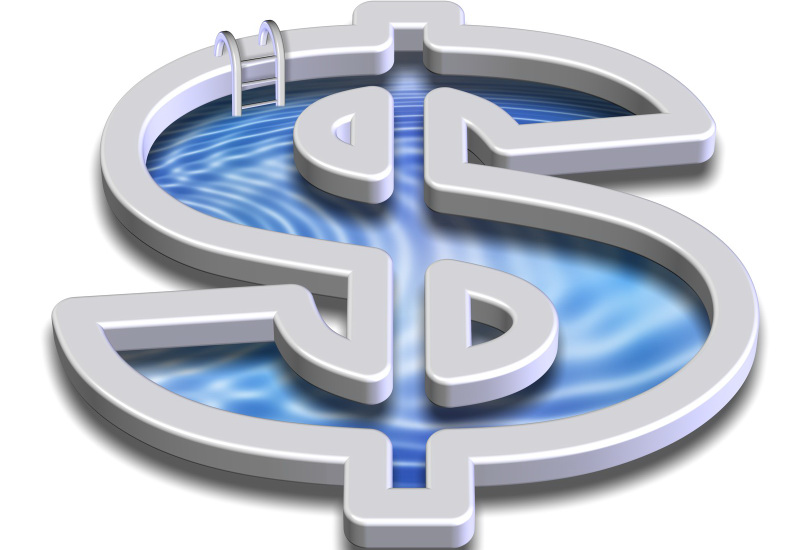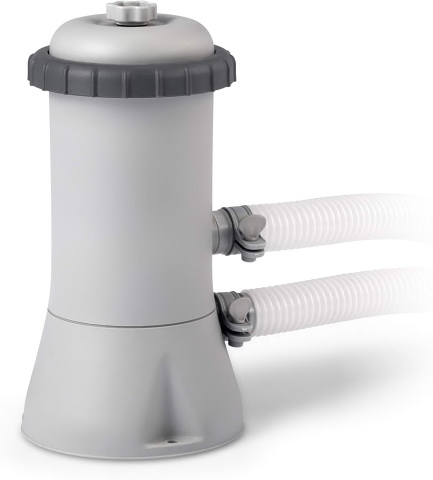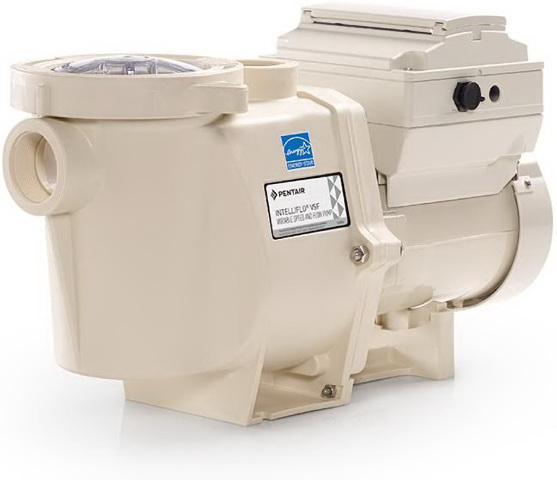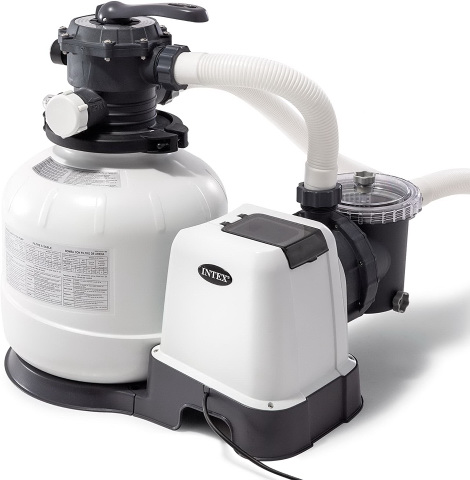If you’re considering buying a house with a pool, are about to build and install a pool or need a new pool pump, then you likely know that the pool’s filter pump is the piece of equipment that costs the most money to run.
In this article I’ll break down the running costs of different pool pumps and which pumps use the least amount of electricity so you can make an informed decision.

Article Contents
How Much Does it Cost to Run a Pool Pump?
The average cost of running a pool pump is $420 per year for a single speed pool pump running for 8 hours a day. The exact cost of running your pool pump is going to depend on the energy cost in your area, and number of hours you run your pool pump, and the size of your pump.
Variable speed pumps cost much less to run and on average cost about 66% less to run than a single speed pool pump. The average cost for running a variable speed pool pump is $142 per year.
* The above numbers assume you’re running a 2.3kWH pump (about 1.5HP), running the pump 8 hours per day and your electricity costs are 10.73cents per kilowatt hour. Your costs will vary depending on the size of your pump, the number of hours you run the pump and the cost of your electricity.
Pool Pump Electricity Cost Calculator
This calculator will work out the cost to run your pool pump (or any other piece of electrical equipment) per day, per month and per year. Here’s how:
1. Check the current rating and select the voltage of the pool pump (find this on the pump or in the specifications). Enter this into the calculator.
2. Enter how much your electricity costs per kilowatt – you can find this on your power bill.
3. Enter how many hours per day you plant to run the pump.
The calculator will automatically work out the costs for you.
How to Calculate Pool Pump Running Cost
And for those of you who want to geek out a little, here how to manually calculate the amount you are paying per year to run your pool pump.

These are five easy steps to calculate your pool pump.
1. Locate the voltage and current (amps) rating
Locate the voltage and current rating plate on your pool pump. The specification should be written on the label or in the manual. Or you could Google the model number of the pump for the specs.
Let’s take for an example; A 1.5HP Hayward Super Pump
The voltage rating is 115V/230V
The current rating is 18.6A/9.3A
There are two ratings here because the pump can run at two different voltages. It doesn’t matter which voltage you pick – the power consumption is still the same.
In this example, we are going to be making use of a voltage and amperage rating of 230V/9.3A
2. Calculate the Power (Energy Consumption) Per Hour
The energy consumption or power can be calculated with the following formula:
Power (kWh) = (Voltage * Current) / 10
That is (230 * 9.3)/ 1000
Power Usage = 2.14 kWh
This pump uses 2.14 kilowatts of power per hour. Now we can calculate the daily energy usage.
3. Calculate the Daily Power Usage
It is going to be very costly and unrealistic to run your pool pump 24 hours a day. The number of hours that is reasonable to run a pool pump is 7-10 hours per day. Although, the chosen run time depends on your preference and the requirements of your pool.
For a more detailed look at how long to run your pool’s pump, check out our article here.
Daily power usage can then be calculated with the following formula:
Daily Power Usage = Power Usage * Number of hours you run a pool pump in a day
If we use the pump for eight hours the power usage will be:
2.14 kWH * 8 hours = 17.1KWh per day
4. Calculate the Daily, Monthly and Yearly Pump Running Cost
To work out the pump running costs in dollars and cents, you’ll need to know how much your electricity costs per kilowatt hour (kWH). The energy cost of your area can be located on your most recent bill.
For example, assume the energy cost is $0.12 per kWh. Now you can calculate the daily, monthly or yearly costs to run your pool pump with the following formula:
Daily Pool Pump Running Cost Formula:
Daily Pump Running Cost = Energy Cost kWH x Daily Power Usage
E.g. 17.1KWh * $0.12 per KWh = $2.05 per day
Yearly Pool Pump Running Cost Formula:
Now you can easily calculate the annual or yearly cost by multiplying the daily cost by 365 days.
Yearly Pump Running Cost = Daily Pump Running Cost x 365
That is, $2.05 x 365 = $748.25 yearly
Monthly Pool Pump Running Cost Formula:
And for the monthly cost, just take the yearly cost and divide by 12. Like this:
Monthly Pump Running Cost = Yearly Pump Running Cost x 12
That is, $748.25 per year / 12 months = $62.35 per month.
Do pool pumps use a lot of electricity?
Pool pumps use a significant amount of electricity since the pump needs to be run for several hours per day and uses quite a large amount of energy compared with other household appliances. In actual fact, a swimming pool can account for more than 17% of your electricity bills.
This surge in your electricity bills are not only due to the pool pumps though, your bills can also be affected by;
- Pool heating systems such as gas heaters, heat pumps and solar heating
- Chlorinating systems
- Booster pumps (for pressure swimming pool cleaners and heating systems)
But wait! Do not let the electricity bills scare you off; this is because the amount of electricity used depends on the type of pool pump used.
If you do care about saving some more cash at the end of summer, you could decide to buy a pool pump with lower horsepower. That means you could go for a 1.5hp pool pump instead of a 2hp pool pump as long as it meets the flow rate requirement of your pool.
The larger horsepower, the more current the pool pump (this current is what you pay for) and thus more kilowatts or power usage.
What Impacts Pool Pump Running Costs?
There are multiple factors that impact the cost of running a pool pump. By being aware of what causes pool pump running costs to be high, and being smart, you can lower your power costs significantly. Here’s what raises pump running costs:
- Type of pool pump (single speed are more expensive to run than variable speed)
- Energy cost in your area (obviously you can’t do anything about this one)
- Number of hours of running your pool pump
- Pool pump horsepower / size (larger pumps use more power)
Before you rush out and turn off your pump to save power. Or go and get a smaller pump, be aware this could affect the health and cleanliness of your pool.
How to Reduce Pool Pump Running Costs
If you’ve ever wondered “Is there a way to reduce the cost of running my pool pump?”, you’re in the right spot.
These five simple tips will reduce your pool pump running cost immediately;
1. Use a variable speed pump or 2-speed pump instead of a 1-speed pump
2. Choose the correct size pump
3. Run your pump at night
4. Run your pump for fewer hours
5. Clean your filter regularly
Cutting Down On Filtering
Most pools need around 8 hours per day of filtering and running the pump. You can however experiment and reduce this by an hour or two and see how your pool water looks. We have an article on how often and long to run your pool pump.
Pool Pump Size
Getting a smaller pump can help too. Many people think larger pumps are better but what they don’t realise is they cost more to run. You’re best not to oversize your pool pump and instead choose the correct size for your pool. The size you get needs to match the size of your pool.
Type of Pool Pump
When I’m talking about the type of pool pump I’m talking about single speed, 2 speed pool pumps and variable speed (VS) pool pumps.
Single or fixed speed pool pumps only run at one speed, around 3000 RPM depending on the model. Two speed pumps have two speeds, just as the name implies – high speed and low speed. And variable speed pumps are able to be set to the optimum speed.
Generally it works out up to 90% cheaper to run a variable speed pump on a low speed 24 hours per day over running a single speed pump for 8 hours. You also get the added advantage of variable speed pumps turning over more water, which means cleaner water.
Most Efficient Pool Pumps
Understandably, you may want to know the most efficient pool pump to use in your home to minimize cost and maximize productivity.
This is why I had to make a list of pool pumps you could buy now that are cost-effective, energy-saving, and highly efficient.
The pumps listed are not in any specific order, I selected these pool pumps as the most efficient based on personal opinion, review from people, and hours of research.
Intex Krystal Clear Cartridge Filter Pump for Above Ground Pools

Intex Krystal clear pump was specifically made for above-ground pools. Specifically pools like Intex, Summer Waves and Best Way pools. It’s also a great way to keep your kiddie pool clean.
It includes one easy-to-clean cartridge that is to be regularly rinsed or swapped to keep the pump running efficiently.
Specification;
- Flow rate is 1000 gallons per hr (GPH)
- Suitable for pools with 32mm hose fitting
Pros;
- Very affordable (under $90)
- The setup of the pump is very simple and easy
- Low running cost
- Ease in cleaning the filter
- Works with various brands of pools
- Quiet operation
Cons;
- The pump has to always be physically close to the pool
- The pump requires regular maintenance
- Only suitable for smaller pools (around 6,000 or less)
>> Click here to check the price and read more reviews.
Pentair 011018 IntelliFlo Variable Speed high-performance pump

Pentair pump offers up to 90% energy savings, this means that it is very cost-effective and electric bills you have to pay annually are significantly reduced.
Specifications;
- 3hp pool pump
- 8 variable speeds
- Compatible with digital pool and spa controls
Pros;
- Saves up to 90% energy
- By filtering for longer at lower speed you’ll have cleaner water
- 8 programmable speed and a built-in timer that ensures desired speed at any time
- Operation is up to 4 times quieter than traditional pumps
Cons;
- Not a cheap option but the ongoing power savings will help.
>> Click here to check the price and read more reviews.
Intex Krystal Clear Sand Filter Pump for Above Ground Pools
Although this isn’t just a pool pump I’ve included it because it’s a very popular option for small pools and includes a sand filter too.
Intex Krystal clear sand pump is used for pop-ups pool or portable pools such as Intex Easy Set Pools, Summer Waves or Best Way. The sand filtration technique is very inexpensive. The sand can also be used for a long time – Intex recommends 5 years before replacement is considered.
Specifications;
- 0.75hp
- 2,450 gallons per hour flow
- 55Kg sand capacity
Pros;
- Very cost effective (less than $500)
- More robust and better filter over Intex Cartridge Filter
- A digital timer is included to turn the pump on and off
- Suitable for medium size pools
Cons;
- Larger footprint

>> Click here to check the price and read more reviews.
Final Thoughts
Calculating the cost of running your pool pump isn’t hard if you follow the simple formulas above. Just calculate the power use per hour, multiply by your energy cost per kilowatt hour and then multiply by the number of hours you run your pump.
Or better yet, use the pool pump cost calculator above and just plug in the numbers for an instant answer!
Related Reading:
Are Variable Speed Pumps Better Than Single Speed or 2 Speed Pumps?
6 Signs a Pool Pump Capacitor Is Bad (and how to test)

